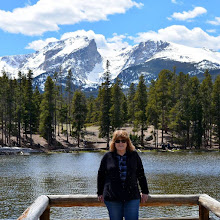When I learned North Table Mountain, in Golden Colorado, had trails leading to its top, I became somewhat obsessed with the desire to hike up it one day to see the views from the top. We drove by it often, on our way to visit family, and it looked like a challenge I wanted to try. (All photos will enlarge for easier viewing if clicked on)
North Table Mountain is actually a mesa, formed about 60 million years ago by lava flows. At the 6,555 feet, (1,998 m) summit of the mesa is North Table Mountain Park. The park is rimmed with fifteen miles of trails and is home to prairie dogs, deer, golden eagles and red-tailed hawks that nest in the cliffs, and rattlesnakes.
My husband and I parked our car in a lot at the base of the west side of the mesa, on State Highway 93, just north of Pine Ridge Road.
The trail up is a wide gravel path and is about a mile long.
It is hard to judge from my photos, but it is a very steep trail--almost straight up in climb.
I had to take it slow and rest often to slow my pounding heart, as the 400-foot elevation ascent was a challenge for me, but those who were younger, and obviously in better shape, were able to run, bike, and climb without resting too often.
Stopping along the way enabled me to take some photos of the volcanic rock formations and look for nesting raptors.
The south portion of the mesa had particularly prominent cliffs.
The last few hundred feet were ahead to the summit...
...and then a look back at where we climbed from the bottom when we reached the top! I made it and was happy to finally be on flat ground again.
Unfortunately, clouds were quickly gathering and we could see the weather was going to change, but we hoped to see as much as we could on the summit before that happened.
Unfortunately, clouds were quickly gathering and we could see the weather was going to change, but we hoped to see as much as we could on the summit before that happened.
It was exciting to be on the top of a mesa and the sheer size of it became apparent right away. We saw trail markers and had to decide which way we would hike.
We decided to hike the Lichen Peak Trail, a narrow "hikers only" trail that traverses through "Lichen Peak Garden," which is a hardscrabble area composed of many basalt rocks covered with various forms and colors of lichen. Lichen is formed by a symbiotic relationship between single-cell algae and fungus. The end of Lichen Peak Trail is the highest point on the mesa, at 6,575 feet (2004 m), and offers a panoramic view.
Please click on to enlarge it.
Lichen can survive in some of the most barren and severe regions on earth, but they are also susceptible to destruction if trampled on, so we stayed on the trail to admire it. We were surprised to see some early wildflowers blooming in April when we made this walk.
There was a fascinating array of different colors of lichen growing on these rocks! Lichen grows at a slow rate of 1mm. per year, so a quarter-size patch could be as much as 25 years old.
The views from the end of the Lichen Trail, which ends in a slight promontory, are amazing! this is the view south.
Facing east we could see the city of Denver, resting a mile high on the distant plains.
Facing south west we saw residential areas of Golden, snugged up against the foothills...
.... and facing north we saw antenna towers dotting the mesa top. Look closely under the lone tree, by clicking on the photo to enlarge it, to see deer resting in the grasses.
Looking back from this point one can look down on the trail that leads up from the parking lot at the bottom, and it gives a good perspective of the steepness of the climb.
We walked back along the Lichen Trail to return toward the North Quarry climbing area.
We walked up the stone steps to the top of the North Quarry part of the mesa.
Looking back from this point one can look down on the trail that leads up from the parking lot at the bottom, and it gives a good perspective of the steepness of the climb.
Walking south towards the end of the mesa...
...where we came upon the "Sea Cliffs" a shiny gorge of basalt rock
Another view looking down at the gorge.
We reached the end of this part of the mesa, and I could look down on some of the town of Golden. Notice the "M" near the top of distant Mount Zion? That is a symbol for the Colorado School of Mines University--a highly rated engineering university located in Golden. I blogged about their Geological Museum on this post.
As we walked back towards the trail heard we could see rain and virga--rain that evaporates before hitting the ground-- on the horizon, and approaching fast, so we picked up the pace...
Driving away toward home, I took one last look back and one last photo--amazed that I could finally say that I made it to the top of North Table Mountain!
I might never have the chance or ability to walk up a 14er, as the natives call Colorado's fifty-eight 14,000-plus-foot mountain peaks, but any challenge is a good one, don't you think? I know I'll return to hike more of North Table Mountain one day in the future.
I might never have the chance or ability to walk up a 14er, as the natives call Colorado's fifty-eight 14,000-plus-foot mountain peaks, but any challenge is a good one, don't you think? I know I'll return to hike more of North Table Mountain one day in the future.

















































































